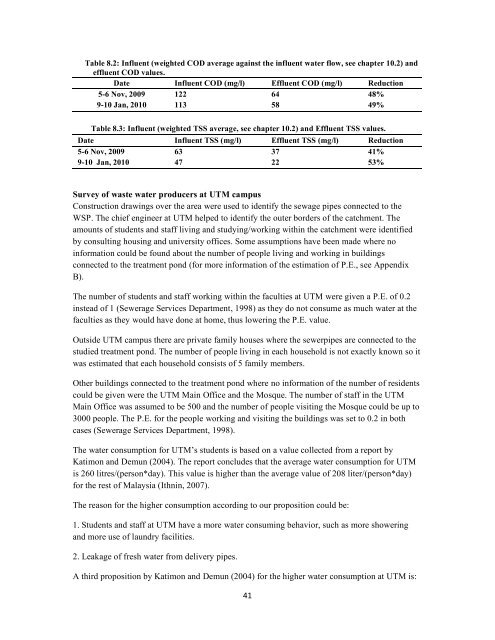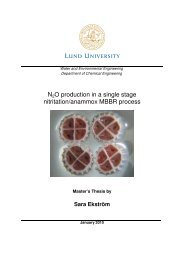Alexander Szabo and Oscar Engle - Svenskt Vatten
Alexander Szabo and Oscar Engle - Svenskt Vatten
Alexander Szabo and Oscar Engle - Svenskt Vatten
Create successful ePaper yourself
Turn your PDF publications into a flip-book with our unique Google optimized e-Paper software.
Table 8.2: Influent (weighted COD average against the influent water flow, see chapter 10.2) <strong>and</strong><br />
effluent COD values.<br />
Date Influent COD (mg/l) Effluent COD (mg/l) Reduction<br />
5-6 Nov, 2009 122 64 48%<br />
9-10 Jan, 2010 113 58 49%<br />
Table 8.3: Influent (weighted TSS average, see chapter 10.2) <strong>and</strong> Effluent TSS values.<br />
Date Influent TSS (mg/l) Effluent TSS (mg/l) Reduction<br />
5-6 Nov, 2009 63 37 41%<br />
9-10 Jan, 2010 47 22 53%<br />
Survey of waste water producers at UTM campus<br />
Construction drawings over the area were used to identify the sewage pipes connected to the<br />
WSP. The chief engineer at UTM helped to identify the outer borders of the catchment. The<br />
amounts of students <strong>and</strong> staff living <strong>and</strong> studying/working within the catchment were identified<br />
by consulting housing <strong>and</strong> university offices. Some assumptions have been made where no<br />
information could be found about the number of people living <strong>and</strong> working in buildings<br />
connected to the treatment pond (for more information of the estimation of P.E., see Appendix<br />
B).<br />
The number of students <strong>and</strong> staff working within the faculties at UTM were given a P.E. of 0.2<br />
instead of 1 (Sewerage Services Department, 1998) as they do not consume as much water at the<br />
faculties as they would have done at home, thus lowering the P.E. value.<br />
Outside UTM campus there are private family houses where the sewerpipes are connected to the<br />
studied treatment pond. The number of people living in each household is not exactly known so it<br />
was estimated that each household consists of 5 family members.<br />
Other buildings connected to the treatment pond where no information of the number of residents<br />
could be given were the UTM Main Office <strong>and</strong> the Mosque. The number of staff in the UTM<br />
Main Office was assumed to be 500 <strong>and</strong> the number of people visiting the Mosque could be up to<br />
3000 people. The P.E. for the people working <strong>and</strong> visiting the buildings was set to 0.2 in both<br />
cases (Sewerage Services Department, 1998).<br />
The water consumption for UTM’s students is based on a value collected from a report by<br />
Katimon <strong>and</strong> Demun (2004). The report concludes that the average water consumption for UTM<br />
is 260 litres/(person*day). This value is higher than the average value of 208 liter/(person*day)<br />
for the rest of Malaysia (Ithnin, 2007).<br />
The reason for the higher consumption according to our proposition could be:<br />
1. Students <strong>and</strong> staff at UTM have a more water consuming behavior, such as more showering<br />
<strong>and</strong> more use of laundry facilities.<br />
2. Leakage of fresh water from delivery pipes.<br />
A third proposition by Katimon <strong>and</strong> Demun (2004) for the higher water consumption at UTM is:<br />
<br />
41















